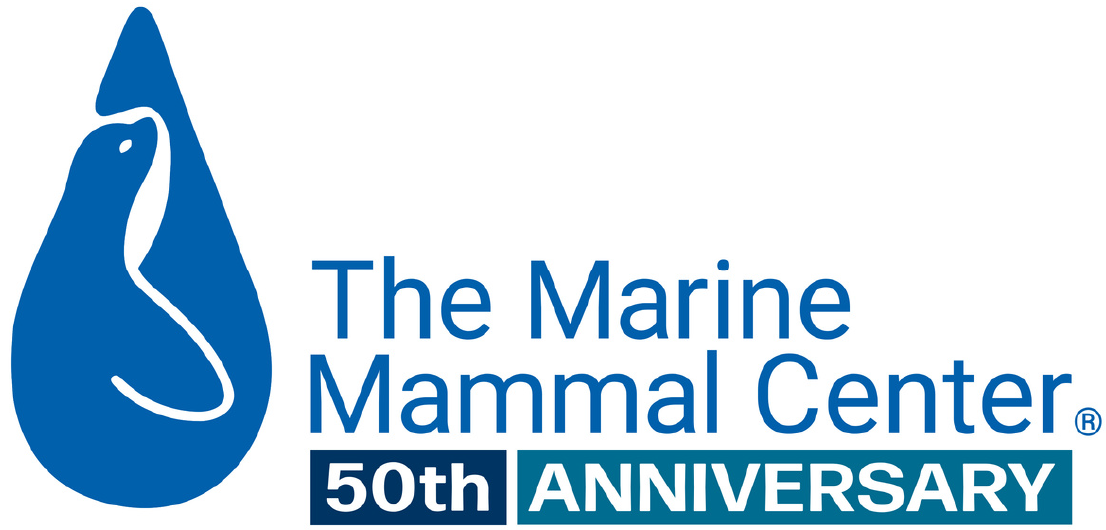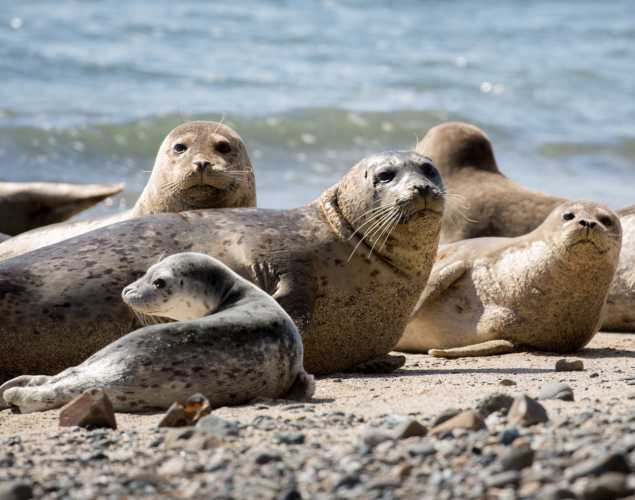
Your Guide to Seeing Harbor Seal Pups in California
- Behavior
- Natural history
Our ocean and beaches are teeming with wildlife, and many marine mammals can be spotted along the California coast. Pacific harbor seals are one such species that are often seen hauling out, or temporarily leaving the water, throughout the year.
Want to admire harbor seals in their natural environment? This guide will get you started. You’ll find tips for identifying harbor seals, discover when and where to view seal pups in the wild, and learn actions you can take to protect the animals you care about.
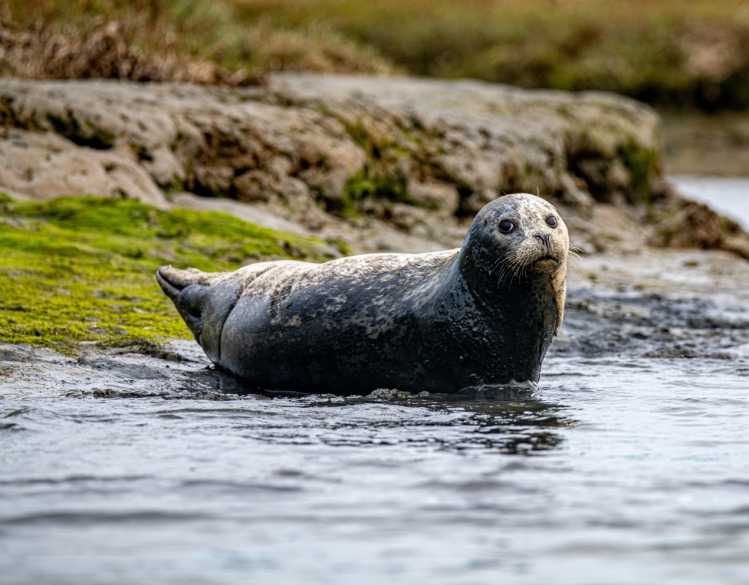
How can you identify harbor seals?
Harbor seals can be identified by their distinctly spotted coats, while their shading can vary from white or silver-gray to black or dark brown. Many harbor seals in San Francisco Bay are also reddish in color, which may be caused by an accumulation of trace elements such as iron or selenium in the ocean.
As part of the true seal family, harbor seals can be distinguished from sea lions by their small flippers and visible ear holes instead of external ear flaps. Learn about the differences between seals and sea lions here.

While elephant seals are also part of the true seal family, the two species can usually be distinguished by their size. Harbor seals are much smaller animals, with adults reaching 5 to 6 feet in length and weighing up to 300 pounds. In contrast, adult male elephant seals can grow to more than 13 feet in length and weigh up to 4,500 pounds; female elephant seals can reach 10 feet in length and weigh 1,300 pounds.
Where do harbor seals live?
Pacific harbor seals are found north of the equator in both the Atlantic and Pacific oceans. In the Pacific, they live in areas ranging from Alaska to Baja California, Mexico. While this species is very widespread, individual harbor seals tend to stay within their small subsections of the larger range. Unlike other marine mammals like elephant seals and California sea lions that may traverse their entire range, harbor seals do not typically migrate far from their natal areas.
Harbor seals favor nearshore coastal waters and spend about half their time in the water and half on land. They are usually a solitary species while swimming and foraging at sea, but they may haul out in small groups to help protect themselves against predators. When on land, they can be seen on sandy beaches, rocky islands, mudflats, bays and estuaries. During harbor seal pupping season, they may also gather in larger numbers at their rookeries, or breeding beaches.
Many of the best harbor seal viewing locations are right here in California!
The health and wellbeing of seals depends on their ability to get enough rest when they are ashore. For your own safety and the safety of marine mammals, make sure to give them at least 50 yards of space, or half a football field.

When do harbor seals give birth?
Harbor seal pupping season varies widely across the regional populations. Seal pups are born progressively later in the year farther north along the Pacific coast, starting in February in Baja California and up until October in parts of Washington State. In California, depending on how far north or south you are, harbor seal pups are born between February and June.

Harbor seal pups depend on their mothers for the first four to six weeks of their lives, during which time the mother seal’s fatty and nutritious milk helps the pup to grow strong. Pups weigh about 24 pounds at birth and gain weight rapidly as they nurse. In the right conditions, the healthy pup will double its birth weight before it is weaned to forage and survive on its own.
During pupping season, you may see pups nursing with their mother, resting in the sand or diving in the water. (Unique to other seal and sea lion species that learn to swim after weeks or months, harbor seals can swim within hours of birth.)
Pupping season is a critical time in a young seal’s development, and any disturbance can sadly put the pup’s life at risk. When observing seal pups and their mothers, you can help by ensuring there is no interruption to their natural behaviors. Protect these incredible animals by admiring them quietly and from a distance of at least 50 yards, or half a football field. If a seal reacts to your presence, move farther away.
What should you do if a seal pup is alone?
If you spot a harbor seal pup alone without its mother, it’s crucial for the pup’s survival that you continue to give it the space it needs (at least 50 yards, or half a football field). You see, it’s a normal occurrence for harbor seal mothers to leave their pups on the beach temporarily as they go to sea in search of food. These seal pups are usually not orphaned, and just resting before their mother returns to nurse them.
If the mother seal sees people or dogs getting too close to her pup, however, her instincts tell her to swim away, and she may permanently abandon her dependent pup. The otherwise healthy newborn seal is then left on its own, defenseless and without the nutrition or skills to survive.

As mothers and pups learn to recognize each other through smells and vocalizations, you may also hear a healthy pup calling out when it is alone or with its mother. Listen to a harbor seal pup vocalizing.
Each spring, as pupping season starts along The Marine Mammal Center’s 600-mile response range in California, our hospital fills up with orphaned and starving pups in need of expert animal care. Why? Unfortunately, wildlife disturbance by people and off-leash dogs is one of the most common reasons marine mammals like seal pups need rescuing.
If a pup appears to be in distress, you can make all the difference by calling our response hotline and giving the animal the space it needs. Our response experts are highly trained to assess the situation and rescue the animal if needed.

How can you see harbor seals in California?
Harbor seals can be spotted year-round in California. Explore the links below to help plan your visit to the best coastal destinations near you where harbor seals may be seen hauling out.
- Redwood National and State Parks - Humboldt
- MacKerricher State Park - Mendocino
- Point Reyes National Seashore - Marin
- Bolinas Lagoon Preserve - Marin
- Fitzgerald Marine Reserve - San Mateo
- Hopkins West Beach - Monterey
- Point Lobos State Natural Reserve - Monterey
- Carpinteria Harbor Seal Rookery - Santa Barbara
- Children's Pool La Jolla - San Diego


For your best chance of seeing seal pups and their mothers, plan your visit around when pups are typically born in your area—February through April south of Santa Barbara, March through May south of Marin, and March through June farther north.
Since some beaches are closed to public access during pupping season to protect pups when they are most vulnerable, you’ll want to follow any signs to view the seals from overlooks, trails and other designated areas. Be sure to confirm online or with your local parks service that your destination is currently accessible before you leave.
What can you do to protect seals?
Even if well-intentioned, people on the beach approaching a marine mammal can sadly cause it extreme stress and even result in a dependent pup being orphaned. Making space for seals is the best way to ensure they can grow strong and live full lives in the wild. When you enjoy marine mammals from a distance, you’ll also get your best chance of seeing their incredible natural behaviors!
Watch or listen to our podcast here to learn more about the impact human interaction has on marine mammals, how our experts are taking action, and how you can be an ocean hero.

Yes, I want to save a life!
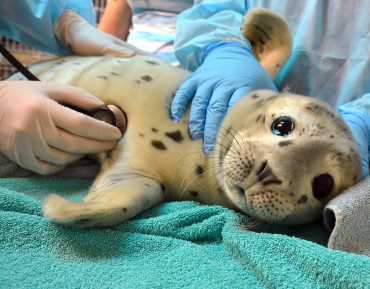
Yes, I want to save a life!
You’ll be giving sick and injured animals the best possible care at the Center’s state-of-the-art hospital. With your gift today, you are giving a patient a second chance at life in the wild.
See Our Latest News
{"image":"\/Misc\/Graphics\/cropped-images\/climate-change-graphic-giant-earth-shutterstock-1798-6-5113-3994-1680046432.jpg","alt":"An Earth Day graphic of people holding the planet, recycling, planting a tree and moving a solar panel.","title":"5 Ways to Celebrate Earth Day","link_url":"https:\/\/www.marinemammalcenter.org\/news\/5-ways-to-celebrate-earth-day","label":"News Update","date":"2025-04-18 11:21:08"}

{"image":"\/Animals\/Wild\/Sea otter\/cropped-images\/sea-otter-mom-pup-photo-c-brian-simuro-505-0-3387-2646-1618247266.jpg","alt":"sea otter mother and pup","title":"Meaningful Mother\u2019s Day Gifts for Ocean Lovers","link_url":"https:\/\/www.marinemammalcenter.org\/news\/eco-friendly-mothers-day-gifts-that-give-back","label":"News Update","date":"2025-04-10 02:00:00"}
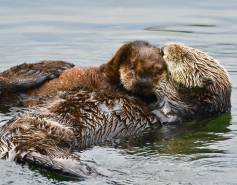
{"image":"\/Animals\/Wild\/Gray whale\/cropped-images\/a-dead-gray-whalesf-bay40225photo-by-josie-slaathaug-c-the-marine-mammal-center-noaa-permit-26532-123-0-1270-992-1743807892.jpg","alt":"stranded gray whale","title":"Scientists respond to two additional gray whales in San Francisco Bay","link_url":"https:\/\/www.marinemammalcenter.org\/news\/scientists-respond-to-two-additional-gray-whales-in-san-francisco-bay","label":"Press Release","date":"2025-04-04 02:00:00"}

Scientists respond to two additional gray whales in San Francisco Bay
April 4, 2025
Read More{"image":"\/Animals\/Wild\/Gray whale\/cropped-images\/2025-03-30-gray-whale-BlackSandsBeach-c-the-marine-mammal-center-206-0-1270-992-1743546220.jpg","alt":"stranded gray whale","title":"Experts respond to a dead gray whale in the Marin Headlands as sightings of the species increase in San Francisco","link_url":"https:\/\/www.marinemammalcenter.org\/news\/experts-respond-to-a-dead-gray-whale-in-the-marin-headlands-as-sightings-of-the-species-increase-in-san-francisco","label":"Press Release","date":"2025-04-01 02:00:00"}

Experts respond to a dead gray whale in the Marin Headlands as sightings of the species increase in San Francisco
April 1, 2025
Read Morenatural history
Harbor Seal
